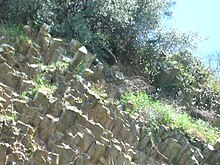You can help expand this article with text translated from the corresponding article in Italian. (June 2023) Click for important translation instructions.
|
| The Thrown Stones | |
|---|---|
| Italian: Pietre lanciate | |
| Nearest city | Bolsena, Italy |
| Coordinates | 42°37′57″N 11°59′50″E / 42.6326°N 11.9972°E / 42.6326; 11.9972 |
| Website | Official website |
The Thrown Stones (Italian: pietre lanciate) is a geological formation of columnar basalt, prisms of volcanic rock rising from the ground, located near Bolsena, Italy.
The shape of the thrown stones has caught the curiosity of many travelers going to Rome. About a kilometer from the town of Bolsena, which leads to Montefiascone along the Cassia, you can observe a columnar basalt rock formation: naturally-formed prisms of volcanic rock.

Etymology

The “thrown stones” the popular term, which is commonly referred to these particular rocks, was coined by the locals in an attempt to understand what seemed like an inexplicable phenomenon. People imagined that the volcano, that is now replaced by Lake Bolsena, had thrown stones during an eruption and that they had driven into the ground.
Morphology
The morphology of this basaltic wall is due to the intense volcanic activity that affected the area one million years ago and in particular to the magma that came in contact with water, which has taken the form of a pentagonal or hexagonal rock column. In some cases the so-called "heads" of the basalts are not smooth, but have a rough surface due to melt conformations called "volcanic".

See also
References
- "Come si è formato | Lago di Bolsena". 2012-10-18. Archived from the original on 2012-10-18. Retrieved 2023-06-15.
- "Descrizione Geosito 03: Pietre Lanciate" (PDF). Archived from the original (PDF) on 2016-03-04.
- Cianchi M.E. (*), Nappi G. (**), Pacchiarotti G. (*), Piscopo V. (*), Sibi P. (*), Valletta M. (*) (*)Dipartimento di Ecologia e Sviluppo Economico Sostenibile dell’Università della Tuscia. Via S. Giovanni Decollato, 1 - 01100 Viterbo (**) Istituto di Scienze della Terra dell’Università Carlo Bo. Campus Scientifico - Loc. Crocicchia - 61029 Urbino (2008). "Il Patrimonio Geologico dell'area al contorno del Lago di Bolsena e dell'alto corso del Fiume Marta, i Geositi e lo Sviluppo Sostenibile. Una proposta metodologica transdisciplinare" [Geological heritage of the area on surroundings of Bolsena Lake and of upper water-course of Marta River, Geosites and Sustainable Development. A multiscientific methodological proposal] (PDF). Mem. Descr. Carta Geol. d'It. LXXVII: 213 - 252 figg. 5.
{{cite journal}}: CS1 maint: multiple names: authors list (link) CS1 maint: numeric names: authors list (link) - "Le Pietre lanciate". PAN. Parchi Ambiente Natura Nel Lazio. Anno 1.: 102 April 2009.
- Nascetti, Giuseppe (February 2010). "Progetto Pilota Geoparco Della Tuscia Censimento E Selezione Dei Geositi Della Provincia Di Viterbo Relazione Generale" (PDF) (in Italian). Tuscia University. Dipartimento di ecologia e sviluppo economico sostenibile (DECOS). Archived from the original (PDF) on 2016-03-04.
External links
- "Parco delle Pietre Lanciate". Commune of Bolsena. 8 July 2022.
- "Bolsena e il sito geologico di Pietre Lanciate". TusciaUP. 10 March 2021.
- "Le pietre lanciate di Bolsena (VT)". Meteo Marta.
- Provincia di Viterbo. Assessorato all’Ambiente. "Alla Scoperta del Geoparco della Tuscia" (PDF) (in Italian). Archived from the original (PDF) on 2011-10-30.